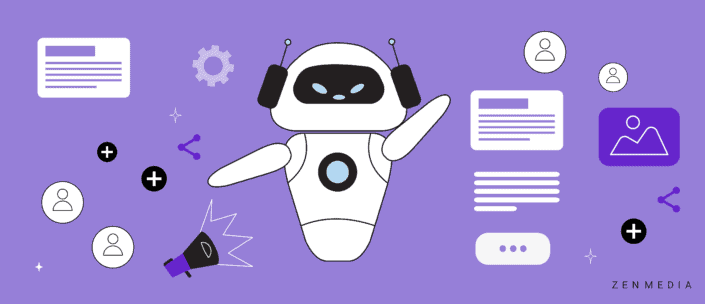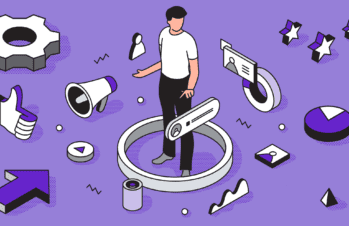With every technology revolution, adoption is an uphill battle. Not because it’s impossible but because change doesn’t come easily. Our reptilian brains, focused on survival, are dead set to remain in the comfort zone. As we know, that’s not where growth happens. New technology can be daunting, and our nature is to resist the unknown.
Today, with infinite information at our fingertips, we are both paralyzed and freed by choice. What are businesses to do with the influx of artificial intelligence tools? Evaluating new options is like playing whack-a-mole; when certain technologies are vetted, more platforms are released.
Adding AI tools to your marketing stack does not need to be painful. By considering the makeup, needs, and current processes, your marketing team can identify the main areas of opportunity for AI adoption in an approachable way.
What about jobs?
One of the main questions that CMOs are asking themselves is how AI will affect their organization’s workforce. Job loss is a leading concern when it comes to AI. We must emphasize that new technologies are constantly changing the economy and the day-to-day roles that are demanded. Take washing machines and dishwashers, for example; they’ve lessened the need for hand-washing clothes and dishes, yet we haven’t seen the end of cleaners, have we? Marketers used to have to create reminders to send out direct mail, which then evolved to email, and now automation is triggered based on buyer behavior.
The World Economic Forum corroborated this point in “The Future of Jobs Report 2020,” which estimated that while AI is expected to replace 85 million jobs worldwide by 2025 (gosh, that’s soon), it will also create 97 million jobs in that timeframe.
Jobs don’t become obsolete, but the day-to-day tasks change, and organizations are responsible for guiding their employees and businesses into the future by being adaptable. Organizations, even those that resist change, will be surprised at the rewarding productivity of AI and how it has changed the way that we work.
Generative and Operational AI
Understanding AI and how it can apply to businesses is essential to actually doing it. Did you know that there are multiple types of AI? For the sake of marketing, there are two that your organization should become familiar with: Generative and Operational.
Generative AI involves systems that generate new data and content based on patterns gathered and applied from existing data. Generative AI uses existing data to then create original content, such as text, images, and even scenarios. Generative models include GANs (Generative Adversarial Networks) and (Generative Pre-trained Transformer) tools like ChatGPT (for human-like text) and Midjourney (for realistic images).
Operational AI centers around the deployment and execution of AI to perform specific tasks and functions in operational environments. Systems are built for practical application and are employed to automate tasks, make predictions, optimize processes, and provide decision support. Chatbots, recommendations in e-commerce, and predictive maintenance are all examples of operations AI.
3 Main Examples of How to Use AI
With the right engineers and data scientists, you can do practically anything with AI. However, starting simple is the way to go. Your marketing team will be impressed with the extent to which out-of-the-box applications allow you to carry out tasks in a matter of minutes.
#1 Prompt writing
Creating a repository of relevant prompts for your marketing team will go a long way. Are there campaigns that the marketing team creates and deploys quarterly? What components are typically included? How many emails are included in each cadence? Is a newsletter part of the strategy? What if you could indicate audiences, desired outcomes, and variables to save more than half your time?
AI can help assist in each of these areas. By reverse engineering your strategy, understanding it, and breaking down relevant categories, your marketing team can create an arsenal of prompts that use company data to outline and craft new campaigns. Human marketers on the team, rather than thinking about a relevant CTA or different ways to communicate the same message in multiple touchpoints, can focus on new offerings, pop culture trends to reference, and stand-out messaging.
Pro tip: Use AI to help write prompts. Yeah, it works.
#2 Reducing the minutiae
By spending a few days in working sessions or engaging with an equipped agency (like us 😉), your team can locate administrative minutiae and reduce it as much as possible.
While this may sound technical, it is simple with the right process-oriented mindset. Automation tools, including smart scheduling and calendar management, can significantly help a marketing team. Promoting a digital-first approach that eliminates the need for email back-and-forths elevates how initiatives are completed. Additionally, companies can internally and externally use chatbots that can handle common queries, provide information, and even perform simple tasks.
#3 Design and creative
Graphic designers now have large suites of generative AI tools that have templated and dynamic designs. These allow designers (or anyone, really) to input a few words to describe a brand, and images, logos, and more are instantly generated. Some of these tools involve Lensa, Microsoft Designer, DALL-E, and Looka, to name a few.
Marketers can equip their teams with these tools to save time on quick mock-ups, creative brainstorms, and even customer-facing or sales presentations. Explaining internally that AI can be used to present an MVP (minimum viable product) shows that the AI is simply cutting down the time it takes to get things done rather than cutting out the people who get the job done. From there, designers can use mockups to design more elaborate and brand-tailored images.
How We Use AI at Zen Media
At Zen Media, we are proponents of AI because we believe that we should grow with the technology that builds our world. We still have a robust, remote team of writers, designers, and operators, all of whom use AI (and still have jobs!)
In 2023, we launched Snooze or News, the first generative AI tool that grades press releases. When companies release PR, it’s imperative that the content is hard-hitting and newsworthy. There’s nothing worse than a story that flops because it’s boring. Snooze or News removes this obstacle, and the AI behind the engine applies decades of industry expertise to rate newsworthiness, provide brutally honest feedback, and help companies land the press they deserve.
We also use AI tools to optimize content and design processes to involve fewer steps, shorter amounts of time, and more accuracy. AI-powered tools also help us to stay organized, reduce busy work, and maximize time spent on strategic decisions for our customers. We have seen the fruits of our labor in using AI for SEO and other department-specific tools. Concepting, outlining, and mocking up are ways we have found AI to significantly decrease time spent on menial tasks and increase time spent on growing the business.
Applying these components changes how a company runs for the better, and all it takes is the willingness to change! Get out of your reptilian comfort zone and into the AI zone. AI in marketing is a MUST. We would be happy to help incorporate AI into your marketing stack to refresh how you work and spend your time.







